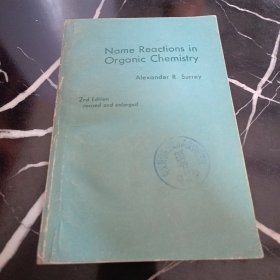
现货Organic Name Reactions & Reagents[9781682510964]
¥ 1434 九五品
仅1件
作者Marri Venkateswarlu, Kamatala Chinna Rajanna
出版社Intelliz Press LLC
ISBN9781682510964
出版时间2016-01
装帧精装
纸张其他
正文语种英语
上书时间2023-08-08
- 最新上架
商品详情
- 品相描述:九五品
- 商品描述
-
A name reaction is a chemical reaction named after its discoverers or developers. Well known examples include the Wittig
reaction, the Claisen condensation, the Friedel-Crafts acylation, and the Diels-Alder reaction. Among the tens of thousands
of organic reactions that are known, hundreds of such reactions are well-known enough to be named after people. As
organic chemistry developed during the 20th century, chemists started associating synthetically useful reactions with the
names of the discoverers or developers; in many cases, the name is merely a mnemonic. Some cases of reactions that were
not really discovered by their namesakes are known. Examples include the Pummerer rearrangement, the Pinnick oxidation
and the Birch reduction. Organic Name Reactions & Reagents covers on reagents and reactions, starting materials, and
desired products. First chapter explores on acetylation and benzoylation reactions of certain aromatic aldehydes, ketones
with Vilsmeier-Haack Re-agents using Acetamide and Oxychloride (SOCl2 or POCl3 ) under con?ventional (thermal) and
non conven-tional [microwave irradiated (MIR), ultrasonic assisted and solvent free mortar pestle (grinding)] conditions.
Second chapter focuses on vilsmeier haack adducts as e ective reagents for regioselective nitration of aromatic
compounds under conventional and non-conventional conditions. Third chapter explores on enantioselective aldol
reactions and Michael additions using proline derivatives as organocatalysts. Fourth chapter proposes on binol based
chirality conversion reagents for underivatized amino acids. We describe in fth chapter the in uence of the addition of
phase transfer catalyst in heterogeneous medium liquid/liquid on the output of the reactions of Darzens and Henry. In
sixth chapter, several N-(p-substituted arylsulfonyl)phthalimides (1a-e) were synthesized and mannich-type reactions of
aldimines with silyl enolates and hetero Diels-Alder reactions of aldehydes with Danishefsky’s diene in the presence of
anion catalysts derived from proline were performed in seventh chapter to a ord the corresponding products in high
yields. Eighth chapter explores on enantioselective aldol reactions of aliphatic aldehydes with Singh’s catalyst. In ninth
chapter, a brief survey of known (and some lesser known) named organic reactions discovered by Italian chemists, along
with their historical contextualization, is presented. Tenth chapter reports on novel (or considerably improved) methods for
the synthesis of aromatic iodides and eleventh chapter reports the oxidative cyclization of analogous enamino carbonyl
compounds with an indole ring, resulting into the for-mation of tetrahydro carbolines. Twelfth chapter presents an
overview of adenosyl radical enzymes, in particular contrasting radical AdoMet and AdoCbl-dependent enzymes, and
discuss whether radical AdoMet enzymes may be active in animals as well as anaerobic microbes. Thirteenth chapter
discloses that biaryl homo- and hetero-couplings can now be realized using aryl halides in the presence of catalytic palladium
and excess magnesium metal with water as the only reaction medium. Fourteenth chapter review reports a short
biography of the Italian naturalized chemist Hugo Schi and an outline on the synthesis and use of his most popular
discovery: the imines, very well-known and popular as Schi Bases. Fifteenth chapter mainly focuses on the general
aspects of the reaction along with its more recent applications. In sixteenth chapter the mechanism of the reaction is
discussed. On this basis the described use in the reaction with electron rich alkenes enolethers, enol esters, enol silyl ethers,
enanines, heterocyclic compounds has been reported. In seventeenth chapter, we describe the design and synthesis of
chiral metal complexes with Zn2+ ions as a catalytic factor that mimic aldolases in stereoselective C–C bond forming
reactions, especially for enantioselective aldol reactions. Their application to chemoenzymatic reactions in aqueous
solution is also presented. The aim of eighteenth chapter is to put in perspective radical chemistry, moving it away from its
origin as a synthetic means for solid supports, to becoming a useful tool for the synthesis of small molecules. In nineteenth
chapter, recent developments concerning the application of polymer supported organometallic reagents in solid phase
synthesis are reviewed, with a special focus on methodology for carbon-carbon formation.
相关推荐
-

Organic Name Reactions
八五品北京
¥ 100.00
-

Organic Name Reaction
八五品北京
¥ 120.00
-

NAME INDEX OF ORGANIC RRACTIONS
八五品北京
¥ 10.00
-

Name Index Of Organic Reactions
七品上海
¥ 30.00
-
![现货Organic Chemistry Name Reaction And Their Mechanism[9789382423966]](https://www0.kfzimg.com/sw/kfz-cos/kfzimg/17733071/4f2d55be6710f842_s.jpg)
现货Organic Chemistry Name Reaction And Their Mechanism[9789382423966]
九五品上海
¥ 1054.00
-

DICTIONARY OF ORGANIC COMPOUNDS NAME INDEX 精 7938
八五品北京
¥ 333.00
-

R My Name Is Rachel
九五品成都
¥ 65.00
-

R My Name Is Rachel (Audio CD)
九五品菏泽
¥ 51.00
-

正版现货 #NAME?
全新淄博
¥ 11.71
-

NAME REACTIONS IN ORGANIC CHEMISTRY【有机化学人名反应】英文
八五品银川
¥ 60.00
— 没有更多了 —
![现货Organic Name Reactions & Reagents[9781682510964]](https://www0.kfzimg.com/sw/kfz-cos/kfzimg/17733071/0b1e4be70bebb9ad_b.jpg)

![现货Materials and Technologies of Modern Production[9783036401683]](https://www0.kfzimg.com/sw/kfz-cos/kfzimg/17733071/5fd2824531e165d7_s.jpg)
![现货Introduction to Container Ship Operations and Onboard Safety[9781032155425]](https://www0.kfzimg.com/sw/kfz-cos/kfzimg/17733071/58b7ff43ef7909ee_s.jpg)
![现货Electrophosphorescent Materials and Devices[9789814877343]](https://www0.kfzimg.com/sw/kfz-cos/kfzimg/17733071/18cc1d77bcb7b488_s.jpg)
![现货Organic Semiconductors for Optoelectronics[9781119146100]](https://www0.kfzimg.com/sw/kfz-cos/kfzimg/17733071/24c85a750c708964_s.jpg)
![现货Advances in Food Rheology and Its Applications[9780081004319]](https://www0.kfzimg.com/sw/kfz-cos/kfzimg/17733071/e0c11603c9119d4d_s.jpg)
![现货Advanced Materials and Sustainable Technologies[9783035727562]](https://www0.kfzimg.com/sw/kfz-cos/kfzimg/17733071/dced675333874c48_s.jpg)
![现货Advanced Materials and Manufacturing Engineering II[9783035712681]](https://www0.kfzimg.com/sw/kfz-cos/kfzimg/17733071/660ccfae75fa8d3e_s.jpg)
![现货Materials in Machinery and Construction[9783035718119]](https://www0.kfzimg.com/sw/kfz-cos/kfzimg/17733071/6f402060775e9daa_s.jpg)
![现货Cereal Grain Quality (Softcover Reprint of the Original 1st 1996)[9789401071772]](https://www0.kfzimg.com/sw/kfz-cos/kfzimg/17733071/f93ca1c96a97403a_s.jpg)
![现货Organic Name Reactions & Reagents[9781682510964]](/dist/img/error.jpg)

以下为对购买帮助不大的评价